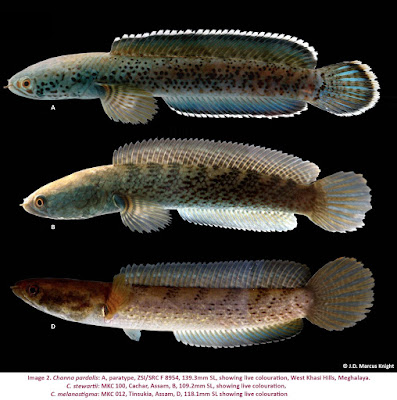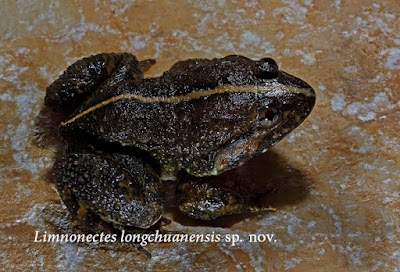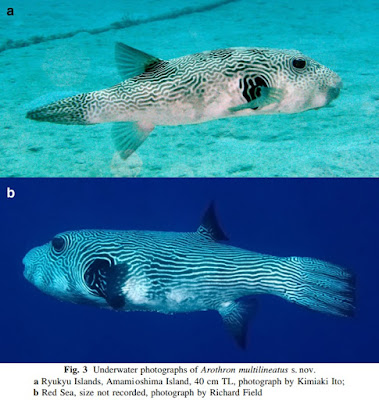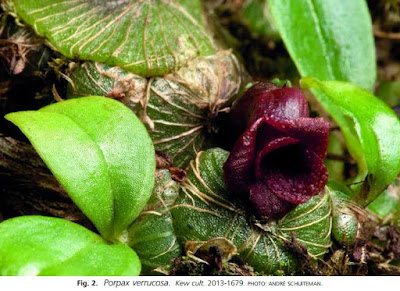[Most Recent Entries] [Calendar View]
Thursday, March 31st, 2016
| Time | Event | ||
| 4:38a | [Ichthyology • 2016] Channa pardalis • A New Species of Snakehead (Teleostei: Channidae) from Meghalaya, northeastern India
Abstract Channa pardalis, a new species of snakehead, is described from Khasi Hills, Meghalaya, northeastern India. This species can be distinguished from its congeners by a unique colour pattern consisting of numerous large black spots on the post-orbital region of the head, opercle and body; a broad white and black margin to the dorsal, anal and caudal fins; 36–37 dorsal fin rays; 24–25 anal fin rays; 44–45 pored scales on the body and two scales on the caudal fin base; 4½ scales above lateral line and 6½ scales below lateral line; 45 vertebrae and the palatine with two rows of teeth: outer row with numerous minute teeth and inner row with short, stout inward curved teeth. Keywords: Channa melanostigma, Channa sterwartii, eastern Himalaya, northeastern India, taxonomy. Channa pardalis sp. nov. (Image 1, 2A) urn:lsid:zoobank.org:act:394A6CAB-1802-4 Holotype: BNHS FWF 181, 127.5mm SL; streams in Nongstoin (25.520N & 91.270E; ~1,400m), West Khasi Hills, Meghalaya, India, coll. A. Rao, December 2012. Paratypes: BNHS FWF 182, 141.1mm SL; ZSI/SRC F 8954, 139.3mm SL, Collection information same as holotype. Additional material: MKC 429, 102.1mm SL; MKC 437, 114.2mm SL, both the specimens were cleared and stained for osteology. Collection information same as holotype. Diagnosis: Channa pardalis sp. nov. is diagnosed from all other species of Channa in having a unique colour pattern consisting of numerous large black spots on the post-orbital region of the head, opercle and body; a broad white and black margin to the dorsal fin, anal fin and caudal fin; 36–37 dorsal fin rays; 24–25 anal fin rays; 44–45 pored scales on the body and two scales on the caudal fin base; 4½ scales above lateral line and 6½ scales below lateral line; 45 vertebrae and the palatine with two rows of teeth: outer row with numerous minute teeth and inner row with short, stout inward curved teeth. Etymology: The specific epithet ‘pardalis’ is a Latin adjective meaning ‘Leopard’ referring to the conspicuous spots the species has, similar to a leopard. Distribution: Channa pardalis sp. nov. is currently known only from the Khasi Hills, Meghalaya, northeastern India. Note: Channa pardalis sp. nov. is known in the ornamental fish trade as Channa sp. Meghalaya leopard. J.D. Marcus Knight. 2016. Channa pardalis, A New Species of Snakehead (Teleostei: Channidae) from Meghalaya, northeastern India. Journal of Threatened Taxa. 8(3): 8583–8589 | ||
| 4:44a | [Herpetology • 2015] Limnonectes longchuanensis • Taxonomic Revision of the Chinese Limnonectes (Anura, Dicroglossidae) with the Description of A New Species from China and Myanmar
Abstract Phylogenetic reconstructions derived from DNA sequence data play a central role in documenting the number of species in a complex. Such analyses are pointing to the existence of many cryptic species, especially in poorly understood groups such as the genus Limnonectes, and the L. kuhlii species complex in particular. To understand the Limnonectes frogs of China, we reconstruct the major matrilineal genealogy of Limnonectes from China and Southeast Asia based on 12S rRNA, tRNAVal and 16S rRNA gene sequences. Based on new data we recognize five species of Limnonectes in China including L. bannaensis, L. fujianensis, L. fragilis, L. taylori (new record), and a new species from southern China and Myanmar. Phylogenetically, the new species is more closely related to the clade comprising L. taylori, L. megastomias, L. isanensis, L. nguyenorum, and L. jarujini from Thailand than to other Chinese species. This study supports previous findings of sympatric members of a species complex that are not each other’s closest relatives. Keywords: Amphibia, Indochina, Limnonectes longchuanensis sp. nov., Phylogenetics, Sympatric distribution, Yunnan Chatmongkon Suwannapoom, Z-Y Yuan, J-M Chen, M. Hou, H-P Zhao, L-J Wang, Truong Son Nguyen, Truong Q. Nguyen, Robert W. Murphy, J. Sullivan, David S. McLeod and J. Che. 2016. Taxonomic Revision of the Chinese Limnonectes (Anura, Dicroglossidae) with the Description of A New Species from China and Myanmar. Zootaxa. 4093(2) DOI: 10.11646/zootaxa.4093.2.2 | ||
| 4:46a | [Ichthyology • 2016] Arothron multilineatus • A New Pufferfish, (Tetraodontiformes: Tetraodontidae), from the Indo-West Pacific
Abstract A new pufferfish, Arothron multilineatus, is described on the basis of four specimens collected from southern Japan. It is distinguished from the other 13 species of Arothron by having many longitudinal white lines on the dark greenish-brown head and body. Underwater photographs of this new pufferfish have revealed that it is widely distributed in the tropical regions of the Indo-West Pacific including the Red Sea. A key to the species of Arothron is provided. Keywords: Tetraodontidae, New species, Arothron, Taxonomy, Distribution Arothron multilineatus sp. nov. (English name: Many-lined Pufferfish; New Japanese name: Tasuji-fugu) Distribution. Arothron multilineatus has been observed by SCUBA divers at depths from 10 m to 25 m on the sandy bottom along the south coast of Amami-oshima Island of the Ryukyu Islands. Judging from collection localities of the type specimens and underwater photographs taken in the Ryukyu Islands (Kimiaki Ito), Mozambique (Angela Lund) and the Red Sea (Richard Field), and a literature record from the Philippines (Schroeder 1980), Arothron multilineatus is widely distributed in the tropical Indo-West Pacific. Etymology. The specific name, multilineatus, refers to many white lines on the head and body. Keiichi Matsuura. 2016. A New Pufferfish, Arothron multilineatus (Actinopterygii: Tetraodontiformes: Tetraodontidae), from the Indo-West Pacific. Ichthyological Research. DOI: 10.1007/s10228-016-0517-8 | ||
| 4:49a | [Botany • 2016] Porpax verrucosa • A New Species (Orchidaceae) from the Cardamom Mountains in Cambodia
Summary A new species of Porpax (Orchidaceae - Epidendroideae - Podochileae) from the Cardamom Mountains in Cambodia is described and illustrated. It is similar to P. elwesii but differs in the much broader and longer, obovate petals that are covered with numerous, glassy, enlarged cells, giving a verrucose appearance. Key Words: Cardamom Mountains, Mekong Region, taxonomy Porpax verrucosa Schuit., sp. nov. Type: Cambodia, Koh Kong Province, Thma Bang Distr., foothills of Cardamom Mts, 23 Nov. 2013, also flowered in cultivation at Kew, 27 Nov. 2014, Kew cult. 2013-1679 (leg. A. Schuiteman, C. Ryan & M. Nut) (holotype K, spirit mat.; isotype Forestry Administration Herbarium, Phnom Penh, Cambodia). RECOGNITION. Similar to Porpax elwesii (Fig. 3) in the non-reticulate veins of the sheath that covers the pseudobulb, glabrous flowers, and in the inflorescence arising from the apex of the mature, leafless pseudobulb. P. verrucosa differs in the broadly obovate petals about as long as the sepals (vs narrowly oblong petals much shorter than the sepals); petals and to a lesser extent the sepals adorned with very large, glassy, swollen cells, giving the appearance of warts (lacking in P. elwesii); sepals at apex shortly apiculate (vs sepals long-apiculate). DISTRIBUTION. Only known from the type locality in Cambodia. HABITAT AND ECOLOGY. Epiphyte on mossy, dead tree trunk in disturbed evergreen hill forest on a ridge crest. Elevation 430 m. PHENOLOGY. Flowers in November. ETYMOLOGY. From the Latin verrucosus, warty, referring to the large, swollen cells on the petals and sepals. CONSERVATION ASSESSMENT. Porpax verrucosa is only known from about a score of specimens found in a single locality on a single tree trunk. Potentially suitable habitat is still widespread in the Cardamom Mountains and since the distribution of this easily overlooked species is unknown at present, its conservation status should be classified as Data Deficient (DD), following the IUCN Red Listing criteria (IUCN 2012). NOTES. This is the first known species of Porpax that is endemic to Indochina. The centre of diversity of the genus lies more to the west, in Thailand, Burma and India. André Schuiteman. 2016. Porpax verrucosa (Orchidaceae), A New Species from Cambodia. Kew Bulletin. 71:4. DOI: 10.1007/s12225-016-9615-z | ||
| 3:40p | [Herpetology • 2016] Unearthing the Fossorial Tadpoles of the Indian Dancing Frog Family Micrixalidae, Micrixalus herrei Abstract Tadpoles of the monotypic Indian dancing frog family Micrixalidae have remained obscure for over 125 years. Here we report the discovery of the elusive tadpoles of Micrixalus herrei from the sand beds of a forested stream in southern Western Ghats, and confirm their identity through DNA barcoding. These actively burrowing tadpoles lead an entirely fossorial life from eggs to late metamorphic stages. We describe their internal and external morphological characters while highlighting the following features: eel-like appearance, extensively muscularized body and tail, reduced tail fins, skin-covered eyes, delayed development of eye pigmentation in early pre-metamorphic stages (Gosner stages 25–29), prominent tubular sinistral spiracle, large transverse processes on vertebrae II and III, ankylosed ribs on transverse processes of vertebra II, notochord terminating before the atlantal cotyle-occipital condyle junction, absence of keratodonts, serrated well-formed jaw sheaths, and extensive calcified endolymphatic sacs reaching sacrum posteriorly. The tadpole gut contains mostly fine sediments and sand. We discuss the eel-like morphology and feeding habits of M. herrei in the context of convergence with other well-known fossorial tadpoles. This discovery builds the knowledge base for further comparative analyses and conservation of Micrixalus, an ancient and endemic lineage of Indian frogs. Discussion This description of the external morphology, osteology and ecological adaptations, of Micrixalus herrei provides the first confirmed report of a tadpole from the ancient anuran family, Micrixalidae. The present study also bridges a significant gap by documenting the life history of at least one representative species from each of the world’s 54 anuran families, which facilitates comparative studies across many disciplines, including development, evolution, and ecology. There is a single report of Micrixalus tadpoles by Smith[14] based on “two poorly preserved specimens said to belong to M. opisthorhodus” (currently M. phyllophilus). According to the basic description provided by Smith[14], these tadpoles bear a single row of keratodonts, which subsequently were considered “characteristic” of micrixalid tadpoles without further investigation[15–17]. This observation is contrary to our finding that M. herrei tadpoles, along with three other micrixalid species (currently being studied in detail), lack keratodonts (tooth rows). Given that many features of the tadpoles described by Smith are synapomorphies with larvae of many other groups, we presume that this description is erroneous. Furthermore, Smith does not mention the fossorial habitat of the two tadpoles, which is their most conspicuous feature. Unfortunately, Smith’s description could not be validated due to the loss of his specimens. We have failed to recover them from any potential museum collections (Natural History Museum, London and Zoological Survey of India, Kolkata). The unusual morphological characters of Micrixalus herrei show convergence with the fossorial forms that are currently known globally. Here we discuss some of the unique features and morphological adaptations of Micrixalus herrei tadpoles that correlate with a fossorial habit. Gayani Senevirathne, Sonali Garg, Ryan Kerney, Madhava Meegaskumbura and S. D. Biju. 2016. Unearthing the Fossorial Tadpoles of the Indian Dancing Frog Family Micrixalidae. PLoS ONE. DOI: 10.1371/journal.pone.0151781 Indian dancing frog's secretive tadpoles unearthed from sand beds http://bit.ly/1Rx3PoF via @EurekAlertAAAS |
| << Previous Day |
2016/03/31 [Calendar] |
Next Day >> |







